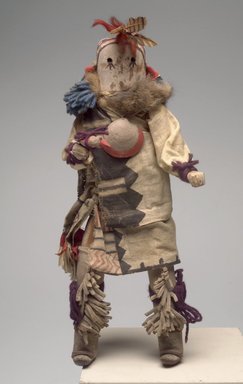
Artist:A:shiwi (Zuni Pueblo)
Medium: Wood, textile, leather, fur, feathers, pigment, shell
Geograhical Locations:
Dates:late 19th century
Dimensions: 14 1/2 x 6 x 4 1/4 in. (36.8 x 15.2 x 10.8 cm)
Collections:
Accession Number: 03.325.4614
Image: 03.325.4614.jpg,
Catalogue Description: Stewart Culin provided the name Kjaklo for this particular kachina doll, which may not be accurate. Now identified as Kiaklo. Feathers are tied to the top of his head. His white face has painted dashes extending out from the bottom of each small eye in three different directions. On one side of his head is a small horn-shaped ear. The kachina is wearing a two-piece textile dress and sash, upon which are painted geometric designs. Around neck are a feather ruff and a disproportionately large shell amulet. Wrists are tied with colored yarn. In proper right hand is a small wooden bird- probably a duck. On kachina's feet are high, long-fringed leather boots, tied at the top with yarn. See the long story about Kiaklo in "Kachinas of the Zuni"pgs. 51-53.by Barton Wright. Involves Kiaklo searching for the middle, being counseled by Duck, and offering to guide him (he had become blind) if he put his shell around Duck. He appears every four years at the initiations of young boys ensuring they are initiated into the Kachina cult and preparing the way for the Salimopea and Kolowisi. The kachina doll is in stable and good condition; however, garment decorations reveal some paint losses. Leather is stiff and appears brittle.